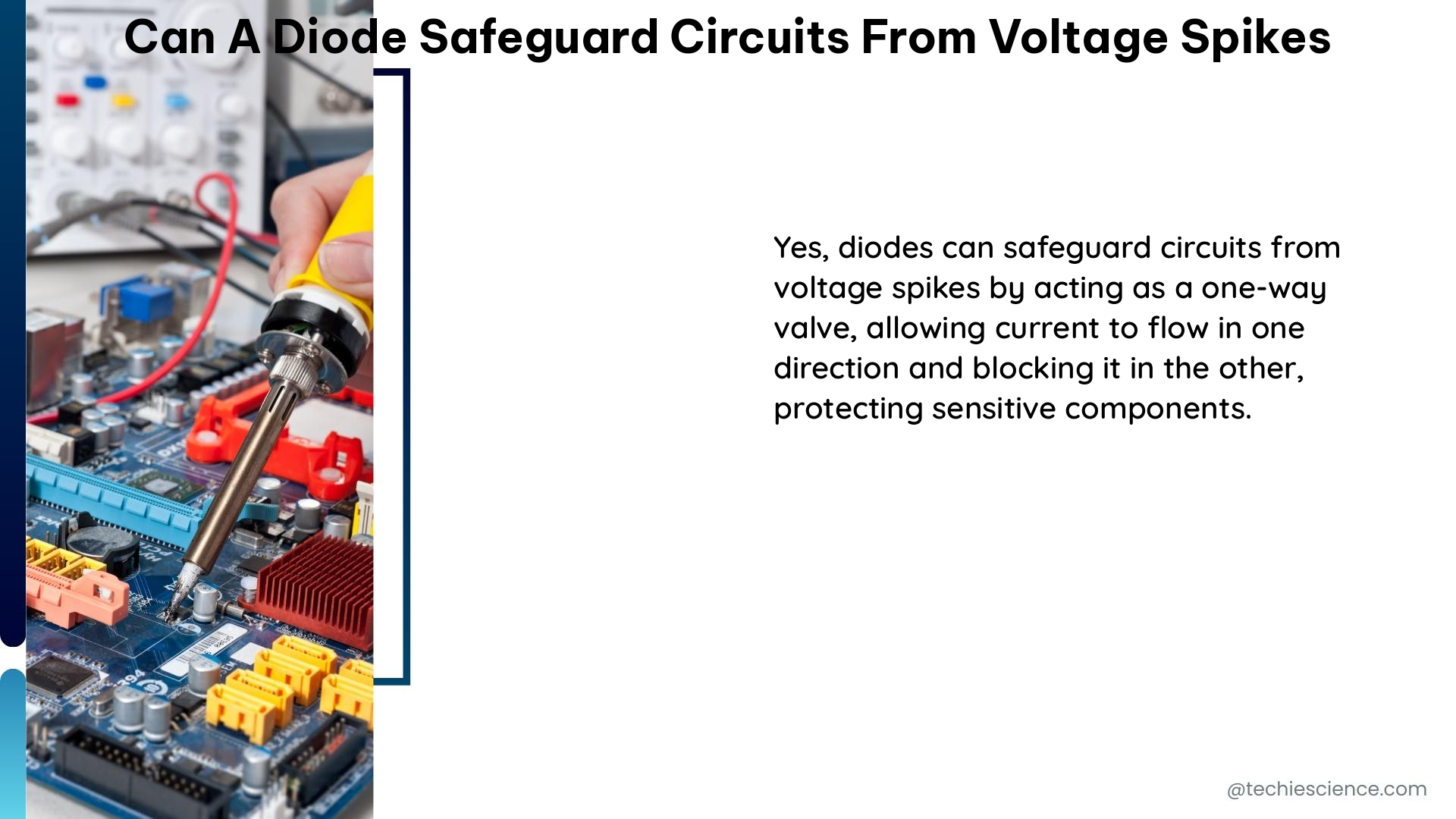Diodes, particularly Transient Voltage Suppressor (TVS) diodes, can effectively safeguard circuits from voltage spikes by shunting the excess voltage to ground, preventing it from entering and potentially damaging sensitive components. This protection is achieved through the avalanche breakdown effect, where the diode begins conducting when the voltage across it exceeds its breakdown voltage.
Understanding Avalanche Breakdown
The avalanche breakdown voltage (VBR) is a crucial parameter in selecting a diode for voltage spike suppression. VBR is the voltage at which the diode will start conducting and shunting current to ground. For instance, the Texas Instruments (TI) TVS diode datasheet specifies VBR as the voltage at which the TVS diode will see 1mA of leakage current and begin shunting current.
The avalanche breakdown occurs when the electric field within the diode’s depletion region becomes strong enough to accelerate charge carriers (electrons and holes) to the point where they can create additional electron-hole pairs through impact ionization. This process leads to a rapid increase in current flow through the diode, effectively shunting the excess voltage to ground.
Key Specifications for Voltage Spike Suppression

When selecting a diode for voltage spike suppression, there are several critical specifications to consider:
-
Avalanche Breakdown Voltage (VBR): As mentioned earlier, this is the voltage at which the diode begins conducting and shunting current to ground. A lower VBR is generally preferred, as it allows the diode to start clamping the voltage at a lower level.
-
Maximum Peak Pulse Current (IPP): This parameter determines the diode’s ability to withstand high current transients during voltage spikes. It specifies the maximum current for a defined waveform that the TVS diode can sustain before failure.
-
Clamping Voltage (VCLAMP): This is the voltage that the system will be exposed to during a surge event. A lower VCLAMP reduces the chance of system failures due to electrical overstress (EOS). VCLAMP is largely determined by the dynamic resistance (RDYN) of the diode, which causes VCLAMP to rise when exposed to a transient current. Therefore, selecting a diode with a lower RDYN can help ensure efficient protection design and minimize system impact.
-
Response Time: The response time of the diode is also an important consideration, as it determines how quickly the diode can react to and clamp a voltage spike. Faster response times are generally preferred to provide better protection for sensitive components.
-
Leakage Current: The leakage current of the diode is another factor to consider, as it can contribute to power consumption and heat generation in the circuit. A lower leakage current is typically desirable.
Selecting the Appropriate Diode
When selecting a diode for voltage spike suppression, it’s essential to carefully consider the specific requirements of the circuit and the expected voltage spike characteristics. The diode’s VBR, IPP, VCLAMP, response time, and leakage current should all be evaluated to ensure the most effective protection.
For example, if the circuit is expected to experience high-energy voltage spikes, a diode with a higher IPP rating would be necessary to withstand the transient current. Conversely, if the circuit is sensitive to high clamping voltages, a diode with a lower VCLAMP would be preferred.
It’s also important to consider the physical size and package of the diode, as well as its compatibility with the circuit layout and available board space.
Practical Applications and Examples
Diodes, particularly TVS diodes, are widely used in various electronic circuits and systems to protect against voltage spikes. Some common applications include:
-
Power Supply Protection: TVS diodes can be used to protect power supply circuits from voltage spikes caused by lightning strikes, electrical grid disturbances, or other sources of transient overvoltages.
-
Data Line Protection: TVS diodes can be used to protect data communication lines, such as Ethernet, USB, or serial interfaces, from voltage spikes that can occur due to electrostatic discharge (ESD) or other sources.
-
Sensor and Instrumentation Protection: TVS diodes can be used to protect sensitive sensor and instrumentation circuits from voltage spikes that can occur in industrial or harsh environments.
-
Automotive Electronics: TVS diodes are commonly used in automotive electronics to protect against voltage spikes caused by alternator switching, load dumps, or other transient events in the vehicle’s electrical system.
-
Telecommunications Equipment: TVS diodes are used in telecommunications equipment, such as modems, routers, and telephone lines, to protect against voltage spikes that can occur due to lightning strikes or other sources of transient overvoltages.
By carefully selecting and implementing diodes, particularly TVS diodes, designers can effectively safeguard their circuits from the damaging effects of voltage spikes, ensuring reliable and robust performance in a wide range of applications.
Conclusion
In summary, diodes, particularly TVS diodes, can effectively safeguard circuits from voltage spikes by shunting the excess voltage to ground, preventing it from entering and potentially damaging sensitive components. The key specifications to consider when selecting a diode for voltage spike suppression include the avalanche breakdown voltage (VBR), maximum peak pulse current (IPP), clamping voltage (VCLAMP), response time, and leakage current. By understanding these parameters and selecting the appropriate diode, designers can ensure reliable and robust protection for their electronic circuits and systems.
Reference:
- Voltage spike suppression w/avalanche diode | All About Circuits
- How can I protect a sensitive Component from voltage spikes?
- Voltage spike suppressors – TVS Diode or MOV – EEVblog
- How to select a Surge Diode – Texas Instruments
- Zener Diode not Zenering at all – Arduino Forum

The lambdageeks.com Core SME Team is a group of experienced subject matter experts from diverse scientific and technical fields including Physics, Chemistry, Technology,Electronics & Electrical Engineering, Automotive, Mechanical Engineering. Our team collaborates to create high-quality, well-researched articles on a wide range of science and technology topics for the lambdageeks.com website.
All Our Senior SME are having more than 7 Years of experience in the respective fields . They are either Working Industry Professionals or assocaited With different Universities. Refer Our Authors Page to get to know About our Core SMEs.